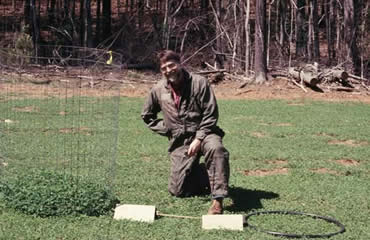What do you mean, you can't tell what time it is without a clock? How much rain did you get last month? Don't have a rain gauge? How long could you go without a gas gauge in your vehicle? How much deer use is there on your food plots? Get the message? A browse exclosure (also called an exclusion cage) simply excludes grazing and browsing by deer, rabbits and other critters is the only accurate way to monitor deer use on your food plots! Period. It is the number one tool in your deer management tool bag especially for browse resilient plants like clovers and small grains.
I started using browse exclosures in the late 1970's and made it mandatory for all 12 of our wildlife management areas in northeastern Georgia. The staff are still using the exclosures today. If you plant food plots, I'm pretty sure you have been there and done that.What I mean is plant your food plot in September and walk away with a great feeling of a job well done. By November your Austrian winter peas are gone. What happened?
By late March, your clover and wheat look like a golf course fairway that has been bombed. It looks pretty bad, not growing well. Who did it? Maybe you skimped on lime and fertilizer, the clover inoculent died, the weather was too cold and dry, poor soil, disease, grubs, or the weeds got it?
Most likely the deer got it but there is no accurate way to tell without a cage. You could have grown the most fantastic food plot in your county but no one including yourself will ever know! With the cage, you can clearly see the difference between the browsing pressure inside and out which may be as dramatic as two inches outside and 20 inches or more inside. There is no substitute for the value of the visual impact of this observation. The difference between inside and out could indicate production of three or more tons of deer forage in a six month period of which half of this ended up in deer stomachs.
A huge difference between inside and out during fall or early spring also runs up red flags about too many deer or not enough food plots or both. Thus the cage becomes an integral part of your deer management plans for next fall whether it is to harvest more does, plant more plots or both. Conversely, small differences may indicate a bumper acorn crop, commercial agriculture such as small grains, standing corn or unpicked soybeans nearby, or even a low deer population. How about a neighbor feeding the heard lots of corn? No way to know all this without cages!
We actually measured clover production and deer use in northeast Georgia in the late 1980's with three clover varieties in a 1.5-acre plot side by side (0.5-acre each). We randomly placed three cages on each variety for a total of nine cages per plot. For 24 months, we clipped clover inside and outside all cages, placed clippings in a paper bag, then moved the cage three yards in a predetermined direction for next month's clipping. We dried the clippings in a special oven (standard practice to remove all moisture and report "dry weight" for comparison) and recorded monthly calculations expanded to a full acre for production and utilization of all three clover varieties. For all varieties, annual production was close to five tons/acre and annual utilization averaged almost two tons/acre! Highest percent utilization occurred in fall, winter and early spring and heavily depended on the local acorn crop. When acorns disappeared (November, January or whenever), clover utilization became heavy. There was no way to know all of this without the cages.
 More calculations and assumptions led us to estimate that forage produced and utilized by deer could account for five to eight additional deer produced per acre of clover plot or an extra five to eight hundred pounds of body weight for the existing deer already using the plot. As a deer manager it is your choice, more deer or bigger deer.
More calculations and assumptions led us to estimate that forage produced and utilized by deer could account for five to eight additional deer produced per acre of clover plot or an extra five to eight hundred pounds of body weight for the existing deer already using the plot. As a deer manager it is your choice, more deer or bigger deer.
There are countless ways to build a simple browse exclosure. One easy way is with a roll of 4-foot tall 2x4 welded wire cut in 10-foot lengths half way between the 2-inch horizontal wires. Use these tag ends to twist around the other end of the wire as it forms a circular cage. Stake down in two or three places with tent pegs, rebar or fence posts. Staking is important as deer will run into them, hogs will push and root them and bears roll or even flatten them! I have seen all three, not that stakes prevent all this, but they help a lot.
In summary, you will be a better deer manager if you build and use browse exclosures. Deer management is like putting together a jigsaw puzzle and browse exclosures are one of the most important pieces to figure out what is going on now and what to do in the future based on what the cages tell you. They are not just for clover and small grains, they are useful in brassicas, peas and beans, buckwheat and grain sorghum. Don't go without cages any longer, it's like operating in the dark!
— By Kent Kammermeyer / Certified Wildlife Biologist/Consultant